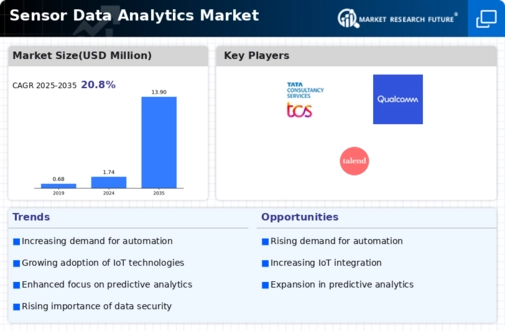Leading market players are investing heavily in research and development in order to expand their product lines, which will help the Sensor Data Analytics market, grow even more. Market participants are also undertaking a variety of strategic activities to expand their footprint, with important market developments including new product launches, contractual agreements, mergers and acquisitions, higher investments, and collaboration with other organizations. To expand and survive in a more competitive and rising market climate, Sensor Data Analytics Industry must offer cost-effective items.
Manufacturing locally to minimize operational costs is one of the key business tactics used by manufacturers in the Sensor Data Analytics Industry to benefit clients and increase the market sector. In recent years, the Sensor Data Analytics Industry has offered some of the most significant advantages to medicine. Major players in the Sensor Data Analytics market, including Tata Consultancy Services, International Business Machines Corporation, SAP AG, Cisco Systems Inc., Microsoft Corporation, Hewlett Packard Enterprise Company, Qualcomm Inc., Schneider Electric SE, Verizon Communications, and Talend, are attempting to increase market demand by investing in research and development operations.
Software development, licencing, and support are all services provided by Microsoft Corp. (Microsoft). The company provides a wide variety of operating systems, server applications, cross-device productivity tools, business solution tools, desktop and server administration tools, video games, and training and certification services. Additionally, it creates, produces, and markets hardware items like PCs, tablets, game consoles, and other sophisticated gadgets. Microsoft and Itron, an American technology business, partnered in May 2022. This partnership aims to enable businesses and smart cities to use cloud computing technology to hasten the cloud-native transition.
Designing and developing wireless telecommunications devices and services is Qualcomm Inc. The business sells system software and integrated circuits for mobile phones and other wireless products. Its product line includes integrated circuits for wireless connectivity, power management, consumer wireless devices, cellular modems, and radio frequency transceivers. The company's products are used in a variety of devices, including mobile phones, laptops, tablets, cellular handsets, cameras, servers, routers, access points, wearable technology, voice and music devices, gateway equipment, consumer electronics, desktop computers, and Internet of Things (IoT) devices.
Brazil, China, Germany, Singapore, India, Japan, Taiwan, South Korea, and the US are among markets where the corporation conducts business. The United States' Qualcomm has its headquarters in San Diego, California. Qualcomm successfully acquired Arriver, an SSW Partners affiliate, in April 2022.

















Leave a Comment